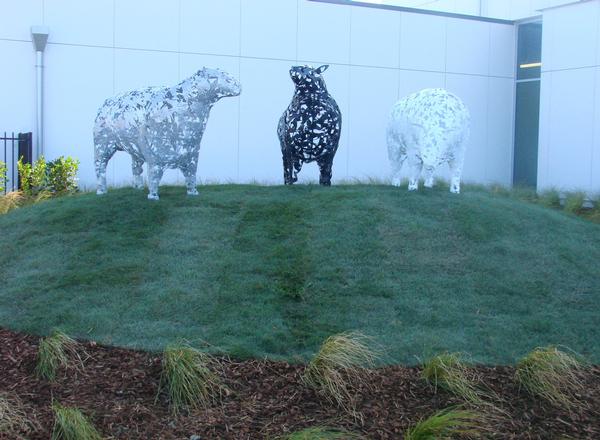Art flocks to Auckland Airport Business District
Wednesday 21 September 2011, 8:50AM
By Auckland Airport
453 views
The sculpture, which was created by renowned NZ sculptor Sean Crawford, was commissioned by Auckland Airport, and pays homage to the pioneering flights of Richard Pearse as a New Zealand aviation innovator.
Peter Alexander, Auckland Airport general manager property, said it was very exciting to today unveil Sean Crawford’s sculpture installation in the Auckland Airport Quad precinct. “The Quad is destined to be the heart of the vibrant Auckland Airport Business District, focused primarily on office activities and support services for passengers and airport workers; including the recently completed Formula 1 hotel and retail shops.” says Peter.
“It’s Auckland Airport’s aspiration to include public art into the landscape as part of our place-making strategy. Sean’s “sheep” sculpture is our first installation and it is a celebration of both aviation and the area’s farming history.”
The sheep have been strategically situated adjacent to the new Formula 1 hotel in an area destined for potential expansion of the hotel. In the future this creative art installation will occasionally be moved to other locations within the Auckland Airport Business District, allowing the “grazing sheep” to be an interactive and transforming experience.
Sean Crawford, who has spent the last two days installing the sculpture, says “It’s great to see it all come together and to see the sheep finally installed. It’s an interesting spot for the sculpture to be positioned and I think having the sheep moved around different areas of the Auckland Airport Business District will really add an extra sense of fun to the installation.”
The Pioneer, Maui's bird and the Earthly star
Written by Sean Crawford, sculptor.
'In the spirit of Pearse who strove to conquer the skies, we as a nation with feet on the ground look to the stars.'
The structure for this work is three life-size steel sheep fabricated from laser cut components. Why sheep? They have become indicative of the New Zealand landscape that they are part of it, so they themselves become part of the canvas. And because they are taken as one on mass, to show individuality in each shows the complexity of the New Zealand cultural experience and landscape. One sheep is black, the other white and one silver.
The silver sheep documents and pays homage to the pioneering flights of Richard Pearse as a New Zealand aviation innovator. It shows the New Zealand spirit of being of the land (as he was a farmer himself), but the determination to reach beyond, while still keeping your feet on the ground. The narrative builds on that character and the connections with the other two works.
The black sheep is fabricated from saddlebacks (Tieke) and this work becomes the muse for man’s fascination with flight. Yet not a great aviator itself, the saddleback’s short flying range mimics man’s first forays into the sky. With its back burnt by the hand of Maui, the saddleback component makes reference to the legend of the capturing of the Sun.
The white sheep is made from clematis flowers (Pauwananga). This flower represents the celestial on earth and is the first child of Rehua and Puanga (stars). This work shows the connection between being of the earth and a want for the stars and sky. The identification of the clematis as an earthly star reminds us to appreciate the beauty and natural wonder of this land.
